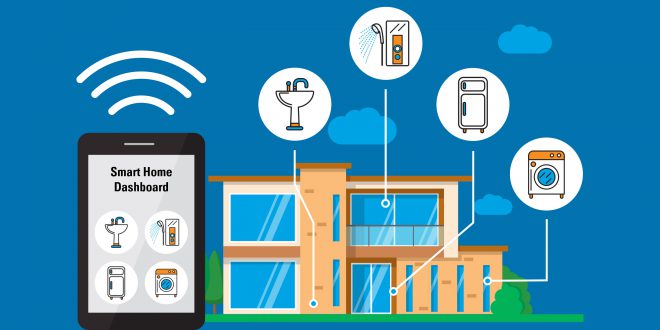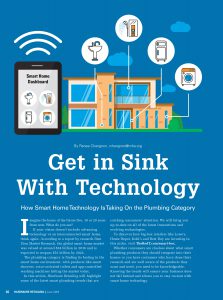
Click the picture to download a PDF of this story.
By Renee Changnon, rchangnon@nrha.org
Get in Sink With Technology
Imagine the home of the future five, 10 or 20 years from now. What do you see?
If your vision doesn’t include advancing technology or an interconnected smart home, think again. According to a report by research firm Zion Market Research, the global smart home market was valued at around $24 billion in 2016 and is expected to surpass $53 billion by 2022.
The plumbing category is finding its footing in the smart home environment, with products like smart showers, voice-activated toilets and app-controlled washing machines hitting the market today.
In this article, Hardware Retailing will highlight some of the latest smart plumbing trends that are catching consumers’ attention. We will bring you up-to-date on all of the latest innovations and evolving technologies.
To discover how big-box retailers like Lowe’s, Home Depot, Kohl’s and Best Buy are investing in this niche, visit TheRedT.com/smart-box.
Whether consumers are clueless about what smart plumbing products they should integrate into their homes or you have customers who have done their research and are well aware of the products they want and need, you need to be knowledgeable. Knowing the trends will ensure your business does not fall behind and allows you to stay current with smart home technology.
A Smart Cook in the Kitchen
In the kitchen, smart home products enhance decor and provide added convenience. According to the 2018 U.S. Houzz Kitchen Trends Study, 9 in 10 homeowners replace all or some of their appliances during a kitchen remodel. Knowing this and wanting to stay ahead of the competition, manufacturers are creating more appliances that integrate smart technology into their functionality, with 25 percent of new appliances including high-tech features, the Houzz study reports. Outside of smart appliances, the kitchen is also becoming a space for the home assistant, which can control different devices through voice commands.
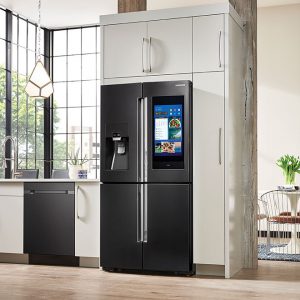
It’s more than an average refrigerator.
In recent years, appliance manufacturers have begun offering smart appliance options. For example, an internet-connected refrigerator is priced higher than traditional units, ranging from $1,000 to $6,000.
A few manufacturers are testing out ways to make the refrigerator even more of a kitchen necessity.
Currently, there are a few models of smart refrigerators that connect to Wi-Fi and communicate through smartphone apps or touch screens.
The high-tech features found in today’s smart refrigerators include the ability to play music, make shopping lists, share calendars and even watch TV on the door monitor.

Voice-activated faucets keep hands free and the kitchen clean.
“Alexa, turn on the kitchen faucet.” More homeowners are utilizing voice-activated assistants, whether it’s Amazon’s Alexa, Google Assistant, Apple’s Siri or Microsoft’s Cortana.
Several manufacturers are taking note and are integrating these smart assistant capabilities into their products. Smart faucets are another smart plumbing product that are starting to get their footing, even allowing a user to turn the faucet on and off just using their voice.
Through smart assistant Amazon Alexa, users can request to turn the water on and off, measure specific quantities of water and even warm water. As a backup, many of these faucets also work through touch.

Stay connected and informed with a smart dishwasher.
With the many tasks a homeowner has to manage on a day-to-day basis, keeping track of different household chores can be tedious. To waste less time and get more done, many companies are designing a suite of kitchen appliances that communicate with the homeowner.
The dishwasher is earning its place in the modern smart home. A handful of manufacturers are creating their own version of a smart dishwasher, which connects the appliance to Wi-Fi and communicating to users through an app.
Smart dishwashers cost anywhere from $500 to $2,000. However, for some consumers, the convenience may be worth it. This type of product allows users to monitor the cycle time and status, lock and unlock controls and it can even reorder detergent pods online all from their phone.
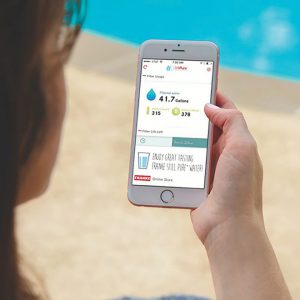
Smart filtration systems ensure water is pure.
For many homeowners, filtered water is essential in the kitchen, whether it’s built into the refrigerator or is attached to the sink.
Several manufacturers have introduced products that fill this need. For example, there is an under-sink filtration system that can deliver filtered water for a variety of tasks, like rinsing, prepping and cleaning. This type of faucet filtration system uses Bluetooth connectivity and communicates through the manufacturer’s smartphone app.
Following up on the trend of consumers looking to monitor and collect data on a variety of everyday habits, a popular feature of smart filtration products is ability track the amount of water a homeowner goes through. Plus, many of these products can reorder filter replacements for the user.

The Technology-Enhanced Bathroom
Smart plumbing and related products are expected to continue being integrated into bathrooms. According to the 2017 U.S. Houzz Bathroom Trends Study, “the demand for high-tech features in toilets and showers grew 19 percent and 26 percent, respectively, from 2016 to 2017.” Many of these features are attracting the attention of homeowners, which has led to more manufacturers creating product lines that connect smart products, from the toilet to the bathtub. Attendees at the 2018 Kitchen & Bath Industry Show earlier this year got a taste of this, seeing the bathroom of the future prominently displayed in several manufacturer booths.
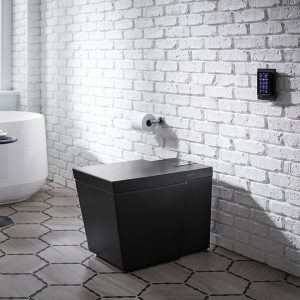
The smartest toilets on the block.
Many manufacturers have sought new ways to advance and enhance the toilet. No longer is this just a standard porcelain throne. Smart toilets integrate many features consumers can get excited about. However, this luxury doesn’t come without a cost. The price tag for smart toilets can range from a couple hundred dollars to as high as $11,000.
These high-end toilets have unique many features, including colored lighting, music synced through Bluetooth technology and heated seats.
Users can control the toilet by using a voice command, an app or a remote. Other features often include automatic flush, a bidet and a toilet that cleans itself.
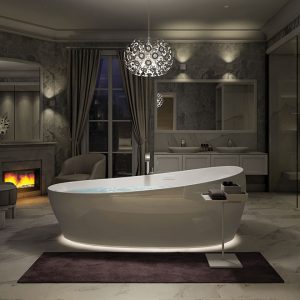
Bathtubs where stress floats away and relaxation is a given.
As consumers continue to seek a spa-like bathroom retreat, the bathtub is an element not to be disregarded.
Plumbing manufacturers are taking the spa preference to the next level, creating stand-alone bathtubs that help users relax.
A new zero-dimension flotation bathtub relieves stress on joints. The tub has a system called hydrohands, which is a dynamic water massage system that flows to targeted muscles. It gives the stimulating sensation of a massage and is free of bubbles and noise.
Another smart bathtub that will be rolled out to consumers this year has the ability to be filled and have several factors controlled all from the manufacturers app on a phone.

Wash your hands, no handles required.
Touchless faucets have been common in public restrooms for years, but now more hands-free faucets are available for the consumer market as well.
Homeowners are adding faucets to the bathroom that rely exclusively on sensors and have no levers or buttons. The user simply waves their hand over the sensor that operates it.
As voice-activated kitchen faucets are popping up, this same technology will likely be available in the bathroom soon, too.
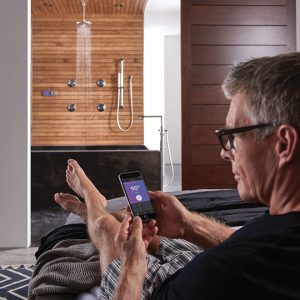
The shower system that gives you what you want.
Smart shower systems are intended to make the task of getting ready for the day or winding down in the evening easy and relaxing.
Using a smartphone app, voice-control technology or the system’s wall controller, homeowners can turn on, stop or pause the shower, and select the temperature.
To create a custom schedule, users can set the amount of time the shower will last and set an alert to know when the shower is on and at the desired temperature.

Leaks, Laundry and Beyond
Smart technology in the bathroom and kitchen have kept people buzzing about smart home improvements, yet there are many other rooms in the house where technology is enhancing and helping the homeowner. For example, major appliance brands have begun creating smart home ecosystems, with several products that can communicate with each other and the user all from one smartphone app.
Manufacturers are thinking of innovative ideas that a consumer would want and need, whether a product is designed to save time or protect your home, like a leak or frozen-pipe detection system.
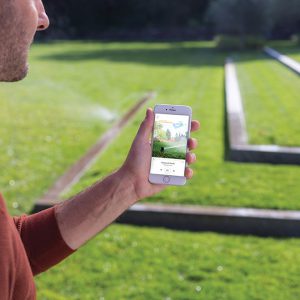
A sprinkler system that knows what to do, rain or shine.
Just as the inside of the home is becoming smarter every year, so is the outside. Smart sprinkler systems connected to Wi-Fi are more common than ever.
What is unique about smart sprinkler systems is that it is able to act as a personal watering assistant, helping users create a watering schedule. The system also uses local weather updates to adjust accordingly. These features save or reduce outdoor water use while keeping plants healthy.
To set up or start watering the yard, a user can access their smartphone app or use voice-control technology to complete commands.
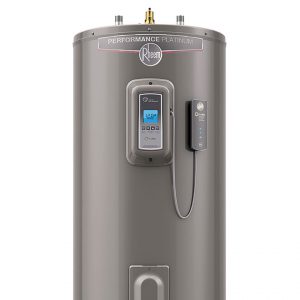
A smarter way to heat the water.
Another household must-have is now available with smart technology is the water heater.
Several manufacturers have been working on bringing smart water heaters to the residential market, providing the smartest, quietest and most efficient water heaters that can also help save money in the long run.
With Wi-Fi connectivity, this kind of water heater can send alerts for anything out of the ordinary, like spills or leaks or reminders on service notifications directly to a mobile phone.
This technology is also popular among consumers looking to save on water heating costs and ultimately save energy.
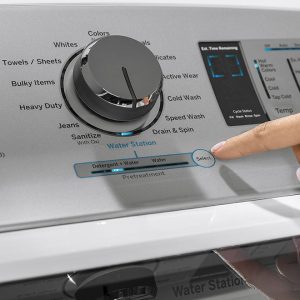
Keep tabs on multiple loads of laundry.
When it comes to chores, manufacturers are providing ways to make them easier. Instead of building a schedule around laundry, homeowners can simply go about their day.
For example, there is a washing machine that can run two loads at once. It is connected to Wi-Fi and users can monitor the remaining cycle time and receive updates through an app. It also answers voice-activated commands to control the machine or order replacement laundry detergent online.

Track and maintain your home water system.
Several manufacturers are taking leak detection seriously, creating smart tools to alert a homeowner before a major disaster occurs.
One of the most comprehensive home water systems available today features a smart water assistant that sends real-time mobile notifications and can turn off the water source remotely through the app.
The water system features a built-in shutoff valve to turn the water off in the event of a leak.

 Hardware Retailing The Industry's Source for Insights and Information
Hardware Retailing The Industry's Source for Insights and Information

